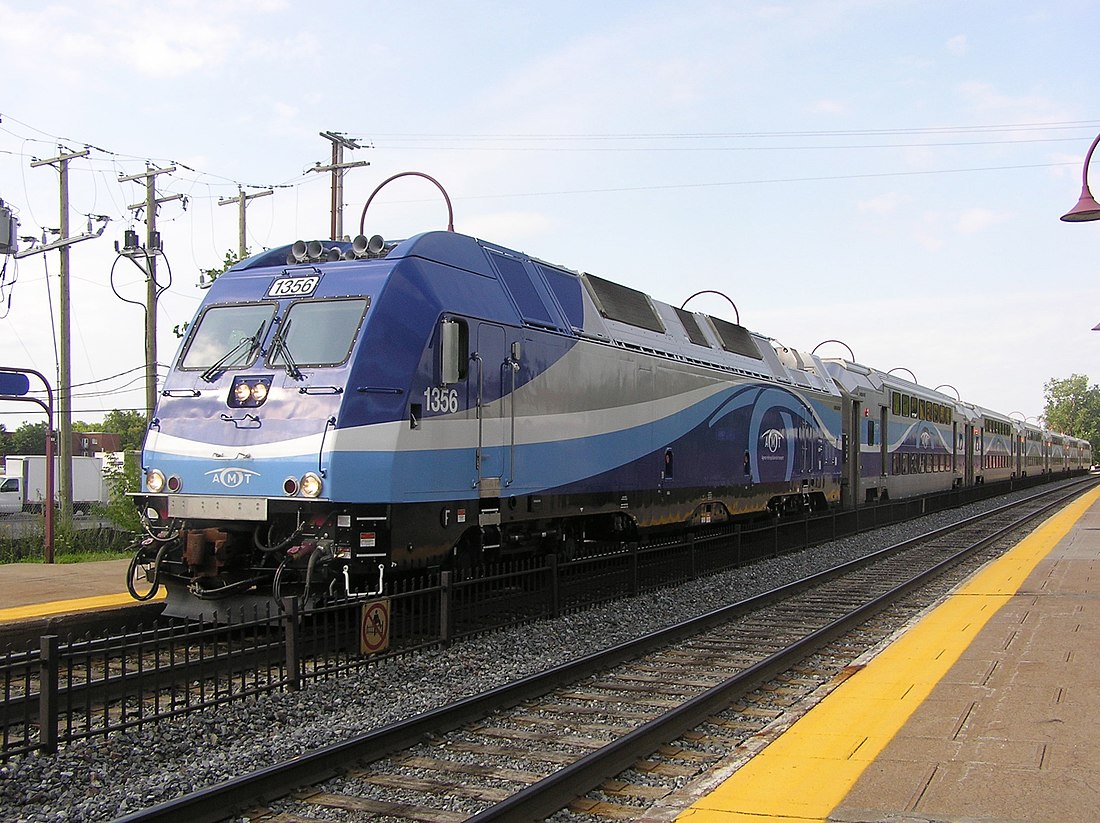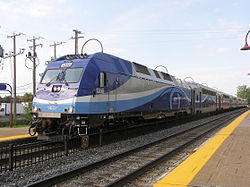Top Qs
Timeline
Chat
Perspective
Vaudreuil–Hudson line
Commuter rail service in Greater Montreal, Quebec From Wikipedia, the free encyclopedia
Remove ads
Vaudreuil–Hudson (also designated line 11, formerly known as Dorion–Rigaud) is a commuter rail service in Greater Montreal, Quebec. It is operated by Exo, the organization that operates the commuter rail network across this region.
The Vaudreuil–Hudson line was originally established in 1887 as a Canadian Pacific Railway (CPR) passenger service known as the CP Lakeshore West line.[3] It was transferred to Société de transport de Montréal (STCUM) on October 1, 1982. It was refurbished between 1982 and 1990. On January 1, 1996, it was transferred to Exo's predecessor agency, the Agence Métropolitaine de transport (AMT). Exo assumed current operation of the line upon its establishment on June 1, 2017.
There are 13 inbound and 14 outbound departures each weekday.[4]
Remove ads
Overview
This line links the Lucien-L'Allier station in downtown Montreal with Hudson to the west of the Island of Montreal. With the completion of the Intermodal station in Vaudreuil, most trains that used to terminate in Dorion, now terminate in Vaudreuil.
The line offers frequent peak-hour service (roughly every 15–20 minutes) to or from Vaudreuil. Outside of rush hours, service is approximately every two to three hours. On weekends, service is approximately every five hours. There are three weekday round trips from the Hudson terminus. All other trains start or ends in Vaudreuil, except for the train that short-turns in Beaconsfield. This is the only line in Montreal to offer semi-express service; reverse peak trains do not stop at certain smaller stations.[4]
The trains are owned and managed by the Réseau de transport métropolitain, and operated by Alstom's Transportation division (formerly Bombardier Transportation).
Remove ads
History
Summarize
Perspective
CP Service
Service on this line started in 1887. Service began with local stops between Montreal and Rigaud being added to trains running between Montreal and Ottawa. Over time, as the population of the western part of the Island of Montreal increased, Canadian Pacific established a dedicated commuter service with several stops on the Island of Montreal and off the western tip of the Island. From 1956 to 2006, service patterns on the line did not change all that much. The average number of weekday round trips hovered around 12, with weekend and holiday service averaging 3 or 4 trips depending on whether the day is Saturday or Sunday.
STCUM and AMT Service
The commuter line was owned and operated by Canadian Pacific until October 1, 1982. On that date, management and ownership of the commuter trains was transferred to the publicly owned Montreal Urban Community Transit Commission (STCUM). The STCUM set fares and schedules, and assumed ownership of the equipment (passenger cars and locomotives) that Canadian Pacific had used to operate the service. Canadian Pacific continued to provide the tracks, stations, storage, maintenance, and train crews needed to keep the line running. For Montreal commuters, the transfer of ownership was positive because the trains were integrated into the bus and metro system. Over time, the commuter line was upgraded with the purchase of new equipment and renovated stations. The line was transferred to the newly formed Agence métropolitaine de transport (AMT) on January 1, 1996.
On July 1, 2010, service to Rigaud was discontinued, as the town of Rigaud was unable to justify a $300,000 annual fee,[5] almost double the previous annual fee of $160,000 required by the AMT to maintain train service for a handful of users.[6] The line now ends at Hudson; the 13-km distance between Rigaud and Hudson represented some 17% of the line's total length. At this time the line was renamed: "Dorion" was replaced by "Vaudreuil" in reference to the terminus for most runs, and "Rigaud" was replaced by "Hudson" in reference to the terminus for the extended service.[7]
RTM/Exo service
On June 1, 2017, the AMT was dissolved and replaced by two new governing bodies, the Autorité régionale de transport métropolitain (ARTM) and the Réseau de transport métropolitain (RTM). The RTM took over all former AMT services, including this line.
In May 2018, the RTM formally re-branded itself as Exo; and renamed each line with a number and updated colour. The Vaudreuil–Hudson line became exo1, and the red line colour was updated to a lighter pastel shade of red. In 2023, the service was renumbered to line 11 in order to be unique within the Montreal rail network.[8]
Remove ads
List of stations
Summarize
Perspective
The commuter line operates over the following Canadian Pacific Kansas City subdivisions:
- Westmount Subdivision (between Lucien L'Allier [0.1] and Montreal West [4.6])
- Vaudreuil Subdivision (between Montreal-West [0.0] and Dorion [18.9])
- M&O Subdivision (between Dorion [0.0] and Rigaud [16.5]; owned by Exo)
References
External links
Wikiwand - on
Seamless Wikipedia browsing. On steroids.
Remove ads



